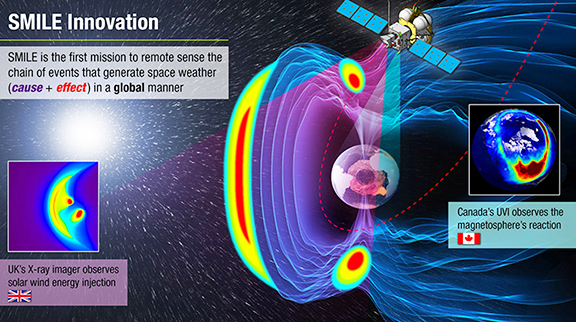
The Canadian Space Agency (CSA) and the University of Calgary, along with other partners, have announced they will develop Canada’s contribution to the Solar wind Magnetosphere Ionosphere Link Explorer (SMILE) mission.

The mission is a collaboration between the European Space Agency (ESA) and the Chinese Academy of Sciences (CAS) to study space weather, the phenomenon that causes the northern lights but can also cause disruptions and damage to technology. Canada is the country with the largest landmass under the aurora borealis, or northern lights, the most visible manifestation of space weather.

This infographic shows what will be observed by the UK's X-ray imager and Canada's UVI.
Image is courtesy of CSA, ESA, NASA, UCL.
Space weather can affect the performance of critical technologies and services both in space and on Earth, resulting in substantial economic impacts. Severe space weather events can disrupt radio communications and satellite navigation signals, damage electrical infrastructure and satellites, and even endanger trans-polar air travel. It is therefore important to try to understand space weather in order to limit its negative effects.
ESA and CAS selected the SMILE mission — the proposal submitted by scientists from the University of Calgary —– from among 13 scientific proposals. The Canadian-led science instrument, the Ultra-Violet Imager (UVI), is funded through an innovative business model that brings together funding from the CSA, the Canada Foundation for Innovation, and Alberta’s Ministry of Economic Development, Trade and Tourism.

The CSA has awarded two contracts: one worth almost $11 million to Honeywell to design the UVI, and the second worth $1.5 million to the University of Calgary to design the UVI Science Operations and Data Center.
SMILE supports the Space Strategy for Canada, as it is a space science mission that aims to help us better understand our planet, our Sun and the radiation environment. SMILE will also contribute to making Canada’s use of space and ground infrastructure more robust against the adverse effects of space weather. The Space Strategy reiterates the importance of space science and the broader space sector. It includes commitments to ensure Canada’s leadership in acquiring and using space-based data to support science excellence, innovation and economic growth, while at the same time positioning Canada’s commercial space sector to help grow the economy and create the jobs of the future.
The SMILE satellite is scheduled for launch in 2023, with an estimated lifespan of three to five years.
SMILE will carry four instruments: one from Canada, one from the UK, and two from China. Canada’s UVI instrument will observe the auroras over the entire northern hemisphere, even during daytime, for 40 hours at a time.
The Honorable Navdeep Bains, the Canadian Minister of Innovation, Science and Economic Development, said this mission will provide the data that researchers need to better understand space weather and the damage it causes. It will also allow governments and industry to better protect satellites and ground infrastructure such as electrical grids that are critical to serving the everyday needs of Canadians.
Ed McCauley, President and Vice-Chancellor, University of Calgary, noted that the SMILE international partnership represents a significant leap forward in the ability to observe and predict space weather. Dr. Eric Donovan’s scholarship in auroral imaging will be a significant asset to the CSA team as they strive to forecast geomagnetic storms and protect global navigation satellite systems and communications satellites. The University of Calgary has contributed scientific instruments to more than 20 space missions the university is proud to advance the4 New Earth-Space Technologies strategic research theme with a role in the SMILE mission.
Marina Mississian, Senior Director, Payloads, Honeywell Aerospace, said the company's space team is proud to once again build on the firm's legacy of providing cutting-edge ultraviolet imaging technology for Canada to share with the world. This mission, to better understand the Sun’s impact on the environment, is essential to help mitigate disruptions to infrastructure and daily life.

